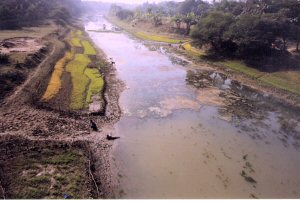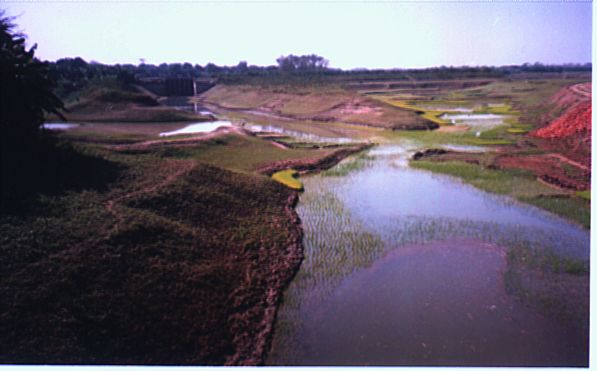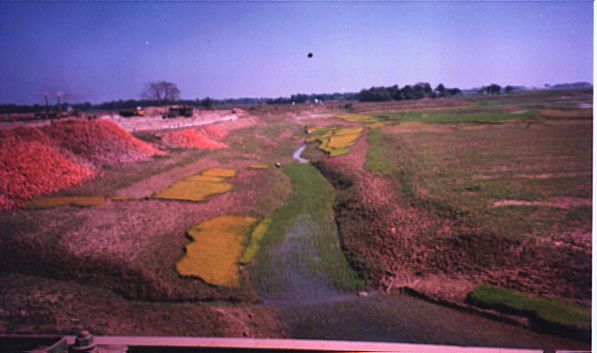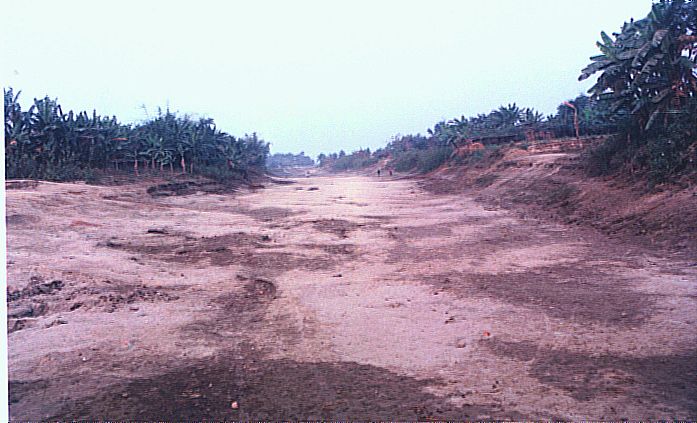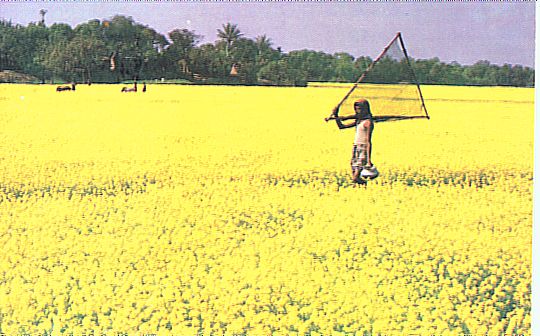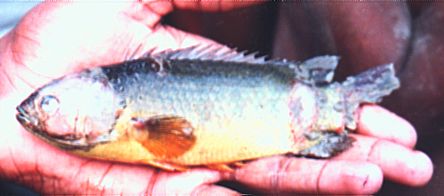Content
- Development Help - Crippled Sustainable Environment and Society
- Dramatic Reduction of Pulses, Oil Seed and Fish
- Farmers at Ambikapur, Kumar River
- Demands of the Farmers
Kumar River, a mighty river that has been flowing since 200 B.C. is a part of the Ganges river. This river reflects the history of the lives of millions of farmers, potters, fishermen, country boat builders, musicians, village poets etc. , people living simple lives for thousands of years. Jasimuddin (1951) writes:
The Ganges, Jamuna, Padma (Ganges), Gorai, Dhalesshari, Meghna rivers of Bengal have spread their silvery songs over the green field as if some unknown musician has struck his fingers softly over the silvery waves and "bhatiali" songs (boatman's songs) play over the sky and air.
It is astonishing to note that these simple people cherished the type of universal humanity that has become now rare all over the world.
A snake charmer sings:
"We cook in one bank, We eat at another,
We have no homes,
The whole world is our home,
All men are our brothers
We look for them
In every door,
Babu (Mr.), many Salams (salute) to you.Or a village musician sings:
"The fishes find the deep sea,
The birds the branches of the tree.
The Mother knows her love for her son
By the sharp pain in her heart alone.
Many diverse the colour of the cows,
But white that the milk shows,
Through all the world, a Mother's name -
A Mother's song is found the same."In Bangladesh, rivers are considered sources of life or death. It is like the Indians (America) who compares life with river. Millions of people live in villages along the Kumar River. In the past, the river gave food, water, and transport to large cities. It flows through Faridpur, Madaripur, Rajbari districts but now a dead river, as many rivers in Bangladesh.

Sailing boat plying through villages to villages before embankment
Construction of Dam and Embankment in early seventy close to the mouth of Padma (Ganges)
River bed silted and almost dried up
During dry period part of the river does not have any water.The "Green Revolution " was introduced in the 1960s. High yielding variety seeds (HYVs) were going to be the magic bullets that would boost agricultural production to levels three or four times as high as could be obtained with traditional crop varieties.
In 1964 Government hired foreign consultants to chart 20 year Master Plan for water resources development. 58 Master Plan Projects at a cost of 2 billion US Dollars were carried out to built thousands of kilometres of embankment to boost agricultural production. Farmers advise was not taken to consideration. Between 1959 and 1993, 482 small, medium and large projects were implemented. The total cost of all these projects exceeded 5 billion US Dollars. The lion share of this money came as loans or grants from donor countries and agencies (Hossain, 1994). At no stage were local people consulted about the design or implementation of any of the schemes. Kumar River Project is one of the most devastating structures that stopped sustainable agriculture and harmonious society.
But in fact, production gains on land behind embankments tended to be short lived. The intensive cropping and excessive use of agrochemicals promoted by the Green Revolution soon began to take their toll, as farmers abandoned traditional methods of soil fertility (flooding irrigation), rotating crop varieties etc. In the mean time, companies such as Ciba-Geigy are doing roaring trade in Bangladesh.
The excessive use of chemical fertilisers (ammonia, nitrates and phosphates) to cultivate HYV rice, indeed, decreases the take-up of natural nutrients, diminishes the ability to hold water and accelerates erosion. The high deposition of ammonium results in an accumulation of ammonium in soil and in a simultaneous leaching of essential nutrients as potassium, calcium and magnesium from the soil and also leads to damage the root system. The rate of higher productivity of HYV varieties is based on the capacity of photosynthesis and the maximum capacity has arrived. The government and many organisations in Bangladesh have reported that the deterioration in soil fertility is attributed to continuous mono-cropping of rice, particularly HYV rice.
Prof Shajahan of BUET (1994) says , "Such flood control and irrigation projects tend to focus exclusively engineering aspects, neglecting the people, water soil, fish, vegetation - many vital concerns."
Due to detritions of soil, moisture oil seed can not be planted as in the past.Dramatic Reduction of Pulses, Oil Seed and Fish
In only seven years, production of wet season (kharif) pulses, plunged almost 13, 200 tonnes (1983-84) to just 1,200 tonnes (1990-91). In the same period, the yield of mung beans went down from more than 34, 000 tonnes to 25, 500 tonnes. The output of other pluses also slumped. It may be mentioned that pulses are the most important source of protein, vitamin and essential minerals for the poor.
In the same period local oil seed (til) went from more than 56, 000 tonnes to less than 49, 000 tonnes. Production of mustard and rape seeds went from more than 253, 000 tonnes to less than 228, 00 tonnes.
According to the Ministry of Environment and Forest (1991), Government of Bangladesh, since the last decade average HYVs and irrigated rice yield have been dropping. Year round transplanted rice cultivation keeps the land waterlogged continuously for many years. This, in turn, leads to the formation of toxic compounds in soil, loss of essential nutrients like zinc and sulphur through deep percolation, and the spread of soil-borne diseases which thrive in this water-logged, and which become difficult to eradicate.
About 3.9 million ha and 1.74 million ha of land is deficient in sulphur and zinc respectively. This has caused a crop reduction of about 10 per cent on an average. Besides there is a rapid decrease in other important crops such as oil seeds, lentils, vegetables etc. The farmers of Bangladesh use to plant them traditionally since thousands of years. Now Bangladesh has to import these items legally or illegally across the borders.
One of the rice co-operatives in Philippines complains about the high cost for the use of fertilisers and pesticides compared to traditional variety - IRRI produces 8 tonnes per hectare which is only 1.75 tonnes higher (Mooney, 1985). There are many commercial advantages to producing entire plantations of uniform, high yielding crops, clonally propagated crops are six times more vulnerable to pests and diseases than their seed-bred counterparts (ATAS, 1982).
The Green Revolution that was to feed the world hungry is destroying the genetic base of the food supply. International Organisations showed that an increase in hunger and malnutrition characterises these areas (Graffin et al., 1976). In Bangladesh consumers complain very high prices of declining quality of vegetables and beyond the reach of poor people. Farmers have to compensate high cultivation costs due to rapidly increasing use of costly fertilisers and pesticides (Chinta, 1992).
The poor farmers can not afford to buy seeds, pesticides and fertilisers at a rapidly increasing price, and at the same time food production is declining.
Manipulation of IRRI evolution is going to make the same mistake as it happened in Formosa at the beginning of this century. The danger of monoculture first became evident with the Irish Potato Famine of the 1840s and 50s. Monoculture, in turn, creates a market for crop chemicals. More advanced varieties of seed will lead to more toxic chemicals, greater risks for farmers, achieves only environmental damage, more chemical residue in food system, increasing production cost and danger of crop loss.
In USA more than a billion pounds of active toxic ingredients are poured onto crops every year, only one per cent hits its target. Since the rise of pesticides, 30 species of weeds and 447 species of insects have become tolerant of the chemicals designed to thwart them. Most of the HYVs producers are also the leading multiorganizations of chemical industry - Sandoz, Upjohn, Limagrain, Cargill, Volvo, ICI, France Mais, Dekalb-Pfizer, BASF, Royal Dutch/Shell, ITT, and Ciba-Geigy, whereas only six are traditionally seed producers. The Royal Dutch/Shell is the highest producer of pesticides and at the same time is the largest seed producer of the world. In fact, the short and long term strategy of the supplying industry is to maximise the use of chemicals and use new bio-technique to broaden the applicability of pesticides (Mooney et al., 1988).
There were about 30,000 rice varieties cultivated by farmers in the Indian sub-continent and at present only 15-variety account 75 per cent of rice cultivation. Pat Mooney and Cary Fowler, the Noble Prize winners of 1985, described as "genetic erosion".
Most prominent of all is the environmental erosion. Not only are the final days of the twentieth century witnessing the genetic erosion of crop resources - a loss of more than half of the diversity of major food plants in a scarce of three decades - we are also observing soil and atmospheric erosion. The new HYVs are unstable to environment, replacing the environmentally sustainable plants that were preserved by our ancestors since thousands of years. Mooney and Fowler (1991) termed HYVs as "threat of seeds of hunger" which threatens the present and future generations.
The rich foreign countries which offered advice and assistance for this project promoted the expansion of HYV rice production. They sold thweir agrochemicals and in appropriate (for Bangladesh) technology to make their profits. And then left the people to pay the price of their mistake (Chowdhury, 1994).
Fish has become almost rare. Toxic water kills the fish. Unknown fish diseases are common these days.In 1988-89 424, 200 tonnes of fish were caught in inland open water, a drop of 10 percent in five years. In 1985 Master Plan Organisation (MPO) estimated loss of 37 kilos of fish per hectare land due to embankments. Many species of fresh water fish have been extinct.
Nasrin, a village woman narrates:
"Our home used to be surrounded and inundated by water. During monsoon, the water would overflow from the rivers into the canals and beels (wetlands), and reach every nook and cranny of our villages. So many species of fish, vegetables used to flourish in the water-bodies which are now almost vanished."
Only well to do farmers cultivate fish in ponds, where they put many toxic pesticides before they begin fish culture. Many foreign varieties have been imported without environmental impact analysis.
A landless farmer says:
"We don't own a pond so can't even dream of eating fish. People who own ponds can eat and sell fish to their heart's content But they don't let us go near their ponds."
The farmers have become poor due to high cost of HYV cultivation. Many poor farmers sell even root of the bamboo, top soil for brick production.Farmers at Ambikapur, Kumar River
The farmers of this area do not cultivate any more HYV varieties because of high cost and pest. Flood water irrigation not only increase crop yield but also brings fish and high ground water level during dry season. But now they can not cultivate many crops because of soil erosion - no fertile soil is deposited on their agricultural land.
Sir William Willcocks, an irrigation expert was extremely impressed by Bengal's ancient system of flood (or overflow) irrigation, which eventually disappeared. In a series of lecture delivered in the 1920s, Wilcocks strongly argued that the ancient system should be revived in Bengal as it best suited the region and the needs of the people. The ancient irrigation system based on floodwater entered the fields through the inundation of canals, carrying not only organic rich silty sediments but also fish which swam through these canals (Khal) into the lakes (bil) and tanks (pukur) to feed on the larva of mosquitoes (Agarwal and Narian, 1997).
According to Wilcocks, the ancient system of overflow irrigation has lasted for thousands of years. Unfortunately, during Afgan-Maratha war in the 18th century and subsequent British conquest of India, this irrigation system was neglected, and was never revived (Wilcocks, 1930). As Wilcocks reveals:
The delta of the Ganges is not a rainless area. It enjoys a rainfall of about 50 to 60 inches, when all rivers are in flood, and to make full use of the rich waters of the Ganges and Damodar floods and the abundant but nutritionally poor water of the monsoon rainfall that some early Bengal king put in practice the system of 'overflow irrigation' of the Ganges and Damodar deltas which insured health and wealth to Bengal hundreds of years. This system is perfectly suited to meet the special needs of Bengal.
Wilcocks observed "river water in the early months of the flood is gold" and made the following remarks when he spent sometime with the peasantry:
I have learnt from these men why they long for the old days when rice fields, tanks and pools were full of fish, which Bernier (an early English traveller) said, were in abundance. The peasantry craves for fish, which were the food for the poor in old days, which they seldom see today... Bernier saw in the 17th century that the overflow irrigation combated Malaria, provided an abundant harvest of fish, enriched the soil and made congestion of the river impossible.
In Bangladesh the government-constructed embankments that prohibit silt-laden flood water and monsoon rain does not drain the low pockets by gravity and caused return of mosquitoes and Malaria. In many areas farmers protests and cuts the embankments but the small rivers and canals (khals) are so heavily silted that the old system can not be reintroduced. We notice that after each severe flood when the rice fields are heavily flooded a bumper crop is yielded in following harvest season. The fertile soil deposited on flood plain in 1987 and 1988 floods, led to unusually bumper harvests, which never taken into consideration by the policy makers.
Demands of the Farmers
The farmers of Kumar River want to get back old Kumar River. I can recall my childhood when sailing boat plying on the river, crocodile, dolphins, floods of fish enter this river with the begin of monsoon. Before the embankment and dam on Kumar river were built, the fish that thrived in farmer's rice fields during the wet season were useful in more ways than one. In addition to being a direct source of food, they also helped to improve organic fertiliser, soil nutrients and ground water.
The stagnant water of Kumar river has not only increased in biological contaminants but also increased in arsenic concentration. Fresh flowing river water will improve arsenic concentration and reduce biological contaminates.
They want:
- Silted river connecting Padma (Ganges) should be dug so that water can enter Kumar River
- This will allow bio-diverse cultivation without chemical fertiliser and pesticides, reduce expenses and reduce migration of poor farmers to the cities.
- The sluice gate that caused siltation should be abandoned or regulator should be workable so that enough water can enter the river and can flood agricultural lands.
- Embankments should not be use to stop entering water. There should be enough gates that can be regulated.
- High areas for flood shelter.
- Reopen sustainable river transport that links all over the county.
Shajahan a poor rickshawpuller seriously poisoned by arsenicThis project strongly support farmer's demand. We wish that farmers can sing again boatman (Bhatiali) songs:
I shall come to you sailing Padma river
Whose ebb and tide carries
The sweet scent of the tall green grass,
In the sky clouds wear the vermilion of god Shaym (god of love).Last modified: August 26, 2004
